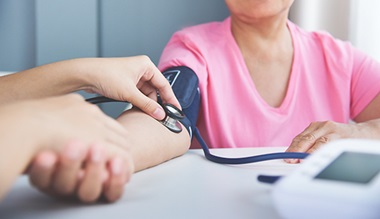Pediatric Hypertension
What is hypertension?
Hypertension is the sustained elevation in blood pressure, meaning it is diagnosed when one's blood pressure is higher than normal on repeated measurements over time. In childhood and adolescence, blood pressure normally increases with age and height. So, a normal blood pressure value for your child will change each year, just as the normal values for their height and weight will change.
A child or adolescent is diagnosed with hypertension when their average blood pressure is at or above the 95th percentile for their age, sex and height when measured multiple times over three visits or more.
Do children really get hypertension?
Yes, and pediatric hypertension is on the rise. Over the last 30 to 40 years, pediatric hypertension in the United States has increased fourfold. Currently up to 4.5 percent — or 3.34 million — of children in the United States have this condition. Recent American Heart Association heart disease and stroke statistics suggest the number affected may be higher, estimating that 15 percent of adolescents have abnormal blood pressure.
While the reason for the increase in pediatric hypertension is not entirely clear, many consider it to be due to the coincident obesity epidemic. Since 1980, the prevalence of obesity among children and adolescents has almost tripled. Thirty-two percent of children in the United States are now overweight or obese. Further, when only considering this group of at risk children, the estimated proportion of children afflicted with hypertension is much greater, ranging from 20 percent to 47 percent.
How do I know if my child is hypertensive?
Your child should have his or her blood pressure measured at least once yearly, ideally at each health care encounter. If your child’s blood pressure is at or above the 90th percentile, testing should be repeated three times, ideally by manual auscultation (using a stethoscope and a blood pressure cuff inflated by hand). If the average of these three measurements is at or above the 95th percentile, your child should return to his or her health care provider for repeat measurements to confirm that their blood pressure is high. If the average blood pressure is less than the 95th percentile but greater than or equal to the 90th percentile (or greater than or equal to 120/80), then your child is prehypertensive and is at risk for developing hypertension. He or she should return in six months for repeat blood pressure measurements to screen for the development of hypertension.
Any child with an average blood pressure at or above the 95th percentile from multiple readings taken over several visits has hypertension.
Does being overweight impact my child’s blood pressure?
Yes. Children who are overweight or obese are more likely to be hypertensive. In addition, being overweight is sometimes the sole cause of a child or adolescent being hypertensive. Individuals who are overweight are also more likely to have other risk factors for heart disease like high cholesterol, diabetes and left ventricular hypertrophy (abnormal thickening of the heart). It is for this reason that ALL children with hypertension should develop heart healthy behaviors.
Why do children with hypertension have to see a nephrologist?
Hypertension in children is often a symptom of another condition or illness. Because of this, all children with hypertension should undergo an evaluation to search for an underlying cause. Kidney disease is a main cause of high blood pressure and hypertension in children, which is why nephrologists are the providers who evaluate and treat this condition in children.
Children who are diagnosed with hypertension should undergo blood and urine testing and kidney and bladder imaging, as well as imaging of the heart.
How do you treat hypertension in children?
Treatment of hypertension in children should focus on the underlying cause and on the institution of a heart healthy lifestyle. Children and their families should adopt a lifestyle that includes the following:
- Weight loss if overweight
- Daily aerobic exercise:
- Aim for 60 minutes or more of moderate to vigorous activity every day — choose an activity that gets your heart pumping like running, soccer, tennis or jumping jacks.
- Minimal sedentary activities:
- Limit activities such as computer/video/tablet games and TV watching to less than two hours per day.
- Regular daily intake of fresh vegetables, fruits and low-fat dairy
- Minimal to no sugar-sweetened drinks:
- Eliminate empty calorie drinks like juice, soda and sweet tea.
- Increase water intake.
- Avoidance of foods high in salt:
- Aim for no more than 1,500 mg sodium per day.
- Take the salt shaker off the table!
- Choose low cholesterol food options:
- Limit cholesterol intake to less than 300 mg each day.
- Stop smoking.
Some children will require medication to treat their blood pressure as well. Children who require blood pressure medication are those with a secondary cause identified, those who are symptomatic from their hypertension, those who also have a diagnosis of diabetes or evidence of organ damage from the hypertension (i.e., left ventricular hypertrophy — abnormal heart thickening) and those who continue to have hypertension after six months of implementing lifestyle changes.
What can I do to prevent my child from developing hypertension?
Because hypertension in children is often secondary to an underlying disease or condition, hypertension can often only be prevented in as much as the underlying condition can be prevented. In many other cases, hypertension can be prevented by adhering to a heart healthy lifestyle that includes a low-fat, low-sodium diet rich in fruits and vegetables, with regular physical activity, avoidance of smoking and maintenance of a healthy body weight.





